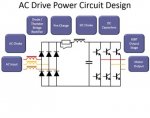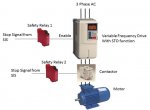from a safety standpoint, it doesn't really matter, the contactor could be on either side. The reason it's often done on the load side is because of the pre-charge circuit.
Take a look at the diagram below. just before the DC link choke, there is a resistor symbol with a contact in parallel. That's the pre-charge circuit.

When you first energize a VFD, the capacitors want to charge themselves instantly, so they pull current at the available fault current rate albeit for only a small fraction of a second. But that can cause damage to the caps, the diodes and everything else. So a current limiting resistor is used to limit that current inrush. That resistor however cannot be left in series, otherwise it would burn out. So a contact is used to bypass it a second after first being energized. There are other ways to accomplish this, but this is the most common.
If you energize a VFD once per day, every day of the year for 10 years, you use that pre-charge resistor 3,650 times. Most mfrs size/rate those components for about 6,000 operations, so lots of fudge factor there. But if you open a contactor on the line side 8 times per day, you exceed that component design life in a little over 2 years. That's why as a general rule, you DON'T want to use a contactor or starter AHEAD of a drive if you can avoid it. So in safety applications where something that has an air gap is required, it's better to put it on the load side, then tie an aux contact of the contactor to the enable circuit of the VFD so that the drive cannot have any output if the contactor is open; i.e. the drive is disabled. In most contactors, a N.O aux contact will change state before the main contacts do, so by wiring a N.O. aux contact of the contactor to the Enable circuit, when you remove power from the contactor coil, the aux contact opens first, the drive output ceases, then the main contacts open.


